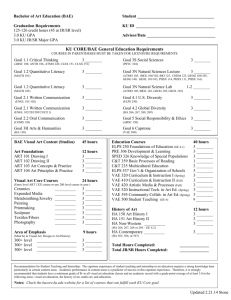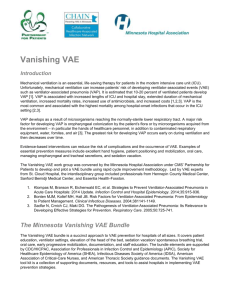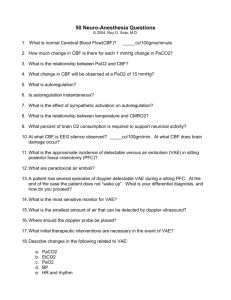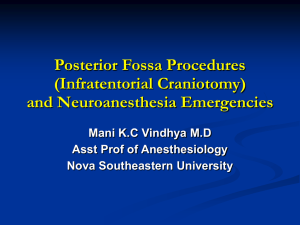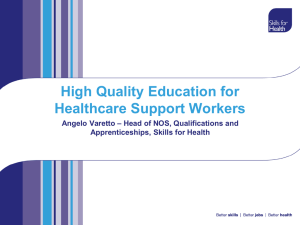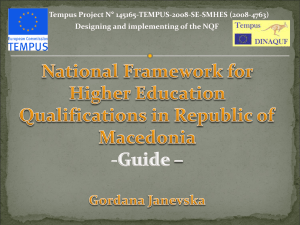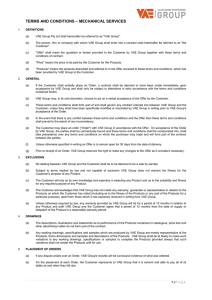The French VAE - Scottish Credit and Qualifications Framework
advertisement
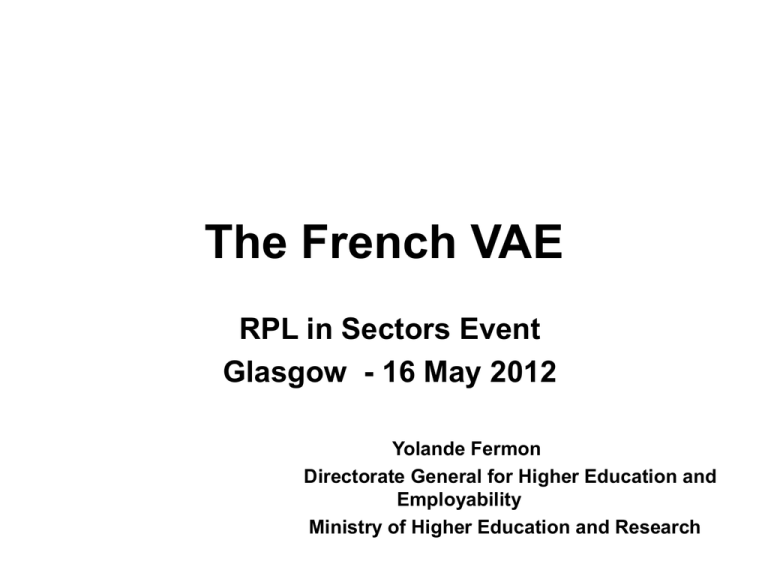
The French VAE RPL in Sectors Event Glasgow - 16 May 2012 Yolande Fermon Directorate General for Higher Education and Employability Ministry of Higher Education and Research France : an old tradition of validation of prior learning and experience . 1934 : « State engineer » qualification procedure . 1985 : Acces procedure to HE (« VAP 85») . 1993 : Partial exemption of units of a degree (« VAP 93 ») • 2002 : Possibilility to award a whole diploma All the systems of validation have common characteristics… • Assessment based on a portfolio with : - a description of the prior experience - evidences of the experience …but different objectives : - access to programmes to take up studying again - award of a partial or a whole qualification The social modernisation Act 17 January 2002 : VAE and RNCP • VAE : an individual right – Anybody involved in active life, whatever his age, profession, situation, – 3 years at least of work experience as an employee, an independant worker or a volunteer the right to have his experience («acquis») validated to get a full or a partial degree (24h VAE leave) Through the VAE : what kind of qualifications ? • A diploma with a professionnal purpose • A title (for example, a title of an engineering school, a management school…) • A professionnal qualification awarded by a sector • All the levels are concerned from the lowest of vocational education to the highest of Higher education The national repertory of vocational qualifications (RNCP) What for ? • Quality assured qualifications which have been accredited by the State • Lisibility of the qualifications for all the actors (individuals, institutions, companies) What qualifications ? 1- Professional qualifications delivered on behalf of the State by different ministries (Education, Higher education, Culture, Agriculture, Social affairs, Youth and Sports…) who have a joint commission These qualifications have the right to be inscribed in the RNCP (but fulfilment of criterias) 2- Qualifications (titles) awarded by ministries who do not have a joint commission, by public or private institutions, by the chambers They are called « titres sur demande » 3- Qualifications awarded by the sectors : les CQP (certificats de qualification professionnelle) The National Commission of vocational qualifications Missions : • Elaboration and updating of the RNCP • assuring the coherence of the certifications (prior advice of the CNCP for any creation of new qualification ) • Information of the public and the companies • Design of a new qualification framework Composition : • Representatives of the ministries awarding qualifications, social partners, qualified persons The CNCP is under the authority of the ministry in charge of vocational further training VAE and RNCP • To be registered in the RNCP a qualification must be accessible through the VAE • To have his VAE financed, the candidate must choose a qualification registered in the RNCP • Each qualification has to be described in terms of learning outcomes (professionnal skills) and must indicate the jobs it leads to, the rate of employability for the last 3 years Important choices made in 2002 • VAE : not a specific system of qualification • The same qualification is awarded through validation as through initial or further training • All the levels of qualifications can be obtained through the VAE • The qualification must be registered in the RNCP (to allow the financing) • VAE is inscribed in the Education and the Labour Codes • VAE is recognised as an activity of further training • VAE is part of the policy for the further training of the employees (law on Guidance and LLL – nov 2009) • What consequences ? • implementation of the VAE is compulsory • A strong integration in the initial certification system and • A strong link with the RNCP and the labour market (stress on the professionnal skills) - A new approach of the qualifications (especially in HE) - Activity and skill standards have to be built to allow a fair implementation of the VAE • A strong integration in the further training system (important for the funding). VAE is part of the policy for further training of the employees (law on Guidance and LLL – nov 2009). • All the institutional actors of LLL are involved. The procedure 1 2 3 4 Information, guidance Admissibility Elaboration of the portfolio and counselling Interview with a jury Who does what ? The candidate The awarding body Chooses The certification Sets up A frame (procedure, schedule…) The activities for which he is asking the validation A medium (portfolio, standards…) The type of evidence Criteria The argumentation method A support to bring out the evidence (counselling) Admissibility of the application A decisive but not final step • Prior to the candidate’s commitment • Strenghening the efficiency A partially predictive compromise • Taking into account the characteristics of the experience, the carreer path, the education and training, the personal evolution, the professional plan, and Taking into account the board of accreditators’expectation concerning the experience in relationship with the degree Filling in the portfolio • Wording the experience : the candidate Reconsiders his path and the key moments Reinvests his work practices Works on the meaning of his activities Brings out the coherence Analyses the activities • Looking for traces : The so-called « administrative evidence » The evidence supporting the description and analysis of the experience Counselling A methodological help to the candidate : • to situate the need of qualification in his professional and personal project • To choose the activities the most relevant with regards to the qualification • To describe their context and the procedures carried on • To translate them in terms of LO (knowledge, skills, competences) • To prepare the candidate to the interview with the jury The Jury • It is not the jury of the « normal » exam • A mixed composition of teachers (or professors) and professional specialists • Tools : activity standard (référentiel de métier ou d’activités) , skills and competences standard (référentiel de compétences) • Must prescribe the best way to get the missing LO in case of partial validation Who finances ? • • • • • The State The Regions The social partners The company The individuals National level • The State : Ministry of labour : through its regional service, credits for all the ministries awarding qualifications : Education, HE, Youth and Sports, Culture, Agriculture, Social Affairs, Employment, Defence • The social partners : the accredited joint bodies that collect the tax employers pay for further training • « Employment Pole » (National Agency for the unemployed) The Region • • • • Since the Law of Decentralisation of August 2004 , Regions are : Responsible for further vocational training and therefore for the VAE Responsible for the information and guidance on VAE (Information and Council Centers) In every region, VAE is part of the policy for employment, Funding can be : – direct help to companies (target sectors according to the needs of the region), – direct help to individuals (target groups – underqualified people, unemployed) The social partners and the company • The accredited joint bodies through 2 main measures : » The individual right to further training (20 hours/year) » The individual training leave (one year) • The Company : VAE can be one of the priorities of the company. VAE is part of its training plan. It can be preceded by training activities. Who has the initiative ? (1) The employee • When he takes the initiative of the VAE, VAE can be payed through 3 measures : 1- His individual right to further training (20h/year) or 2- The VAE leave : 24 hours (= 3 days) or 3- His individual right to further training leave (1 year) Who has the initiative ? (2) The employer • VAE is included in the company training plan • VAE must be implemented with the agreement of the employee • All the expenses are payed by the company on its training budget or by the accredited joint body of the sector the company belongs to • A contract has to be signed by the employer, the employee, the institution delivering the degree and implementing the VAE The individual He pays : • When he wants to keep his validation secret from his employer, • When he cannot get any help from the company, nor from the accredited joint body, nor from the Region (very rare) What are the benefits ? (1) For the individual : • A better self professional awareness • A mean to take his destiny and further training in his hands • More self-esteem • A recognition by the others • An evolution in the company (better position) • The opportunity to move to another company and get more qualified and better payed job • A reduction of the training time • An incentive for more training What are the benefits ? (2) • • • • • For the company : A response to meet the new needs for qualified workers, A more efficient management of the human resources and competences Workers more involved in the company A better image that can attract new employees (in sectors where offer is bigger than demand) A reduction of the costs of training What are the benefits ? (3) For the society : • The responsability of training shared between the society and the individual • A general rise of qualification to respond to tomorrow challenges, • A valorisation of certain undervalued jobs (social sector) • Less unemployment and problems linked to it More social cohesion ! The figures in 2010 • • • • 75 000 applications = admissibility 53 000 candidates = jury 30 000 validations (full qualifications) awarded The most awarded qualifications : National Education (13 300 - 43 % of the validations) Ministry of Health and Social Affairs (7500) Ministry of Employment (5500) Ministry of Higher Education and Research (2200) • 7 candidates on 10 are women • 2/3 of the candidates for qualifications of the lowest levels (French NQF, levels 5 and 4 = EQF levels 3 and 4) • 21 % of the vocational and technical qualifications of the Ministry of National Education are got through the VAE
